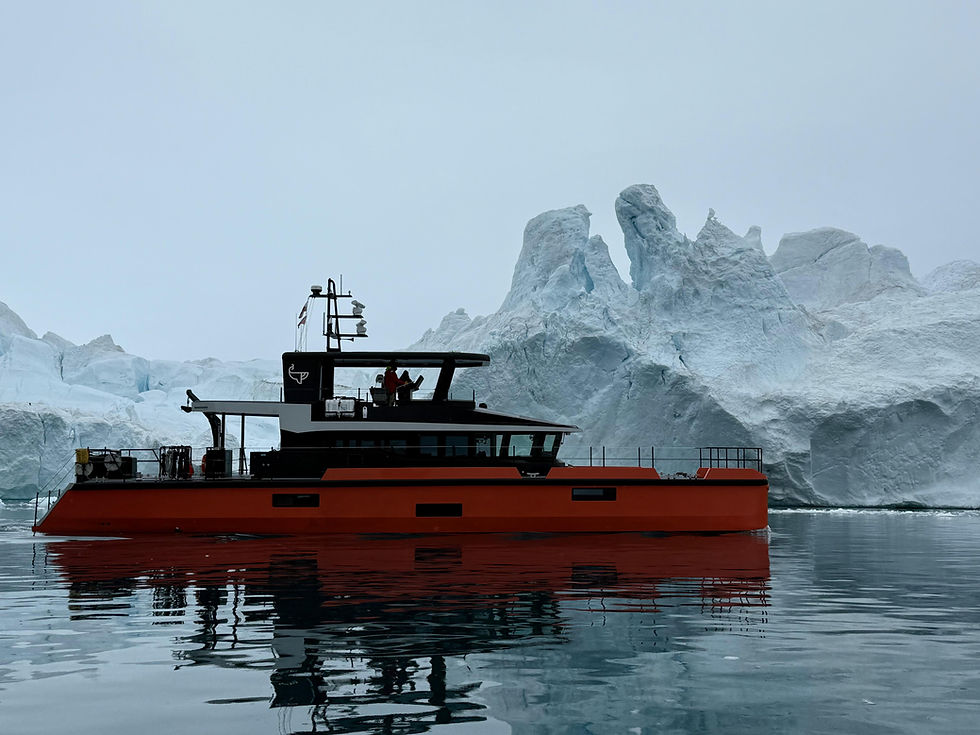Designing a Robust Hull Structure
- Jun 25, 2021
- 3 min read
Updated: Mar 31, 2023
We build yachts to design rules in this day and age. The major Classification Societies all have their take on this though they are predictably similar, based on the same theories and a twist of practical experience. So, a fishing boat in Seattle will have similar scantlings to one in Bergen, Durban or Kaohsuing, for that matter. Rules change a little when considering operation in higher latitudes or indeed any areas where help is scarce. There is a tendency towards increasing the factor of safety for both equipment and the hull itself. But just how has this become manifest?

LRC 58, aluminium hull, long and very fuel efficient. Increasing those scantlings adds nothing to weight and so much to strength.
Yacht Hull Design: Theory
Let us start with a little theory. The bending resistance of a plate or beam depends on both the substrate’s physical property (in this case, aluminum) and its thickness. Thickness affects the distance from the neutral axis in the direction of deflection. Bending strength varies with the square of the distance from the neutral axis (second moment of area). So comparing two beams of uniform thickness but one being twice as deep as the other will be four times stiffer. One three times as deep will be nine times stiffer. The practical limit is the yield strength of the substrate, the point at which it deforms plastically. Aluminum deforms fairly easily under such conditions (hence extrusions), steel does not.
Yacht Hull Design: Options
With that out of the way, two design changes increase the hull protection for any given design geometry. Increase the depth and number of hull scantlings (supporting the outer skin) and increase the thickness of the hull skin. For this class of yacht, the first examples progressing this philosophy are found in the FPB range. Their website has a good article explaining in detail how they implemented this on an FPB 78. Not only is the outer skin considerably thicker than Code all over, but they also paid particular attention to the forefoot, sole, and other more vulnerable areas of the hull plating. Some examples are three times what a naval architect would typically advise. Attention to the supporting framing with closer spaces and again increased scantlings. The result is a significant inherent factor of safety for the hull from the main deck downwards and especially the underwater surfaces.

FPB78 showing varying thickness of hull plating. (ref setsail.com)
The LRC 58 has an option for increasing the specification for the scantlings and hull plating. Artnautica Europe advised that this has not occurred on the first five, see below for the build of hull No 3. A logical reason would be the intended cruising grounds for these more modestly sized vessels does not require it. The yard that built LRC58-03 and LRC58-05 (Aluboot) also built many boats for the Whitbread Around The World Race. Their feedback is you have to be pretty unlucky to hit anything in the ordinary way of matters. With such feedback, it really is an owner’s decision either way.

LRC58-03 under construction in The Netherlands
The XPM78 from Naval Yachts has followed FPB practice. The enclosed photos show how this happens on Vanguard (XPM78-02). I would also refer the reader to an article on mobius.world discussing the build of the first XPM78-01. The stem and keel plate increased from 10 to 25mm. The depth of the stem at the forefoot increased from 50 through over 250mm. The hull plating in this location grew from 8 to 12mm. Additionally, a watertight compartment has been configured forward of the vulnerable forepeak and complimented with closely spaced horizontal stringers. The metal contacting rogue containers, trees, earth, or ice is now a monumental 49mm (circa 2 inches) in thickness when considering both the stem and hull plates, backed with a closely spaced supporting framework and two watertight compartments.

Framed XPM78-02 hull ready for the final skinned internal tank tops. Stringers increased from 5×10 on 400mm pitch to 10 by 100 on 300mm. 8-10 times stronger!

Details of the bow showing the substantial stem, additional watertight bulkhead, and close stacked horizontal stringers.
Yacht Hull Design: Final Thoughts
I think Wayne, builder of Mobius, coined the phrase “SWAN” – Sleep Well At Night. A philosophy that this class of yachts follows with aplomb.
Read also: XPM-78 Designing the First Hull
Anyone interested in further reading on this subject would do well to secure a copy of Dave Gerr’s book: Elements of Boat Strength for Builders Designers and Owners, ISBN: 978-0-07-170321-5, McGraw Hill, 2000.
Happy reading!
Chris Leigh-Jones







Comments